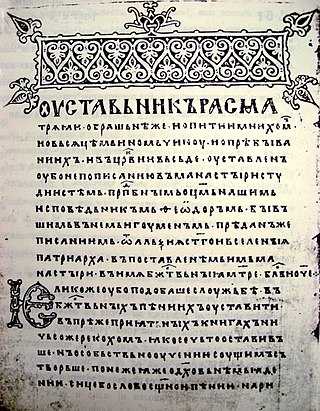
An alphabet is a standardized set of written letters that represent particular spoken sounds in a language. Specifically, letters correspond to phonemes, the categories of sounds that can distinguish one word from another in a given language. Not all writing systems represent language in this way: a syllabary assigns symbols to spoken syllables, while logographic systems assign symbols to spoken words, morphemes, or other semantic units.

The Cyrillic script, Slavonic script or simply Slavic script is a writing system used for various languages across Eurasia. It is the designated national script in various Slavic, Turkic, Mongolic, Uralic, Caucasian and Iranic-speaking countries in Southeastern Europe, Eastern Europe, the Caucasus, Central Asia, North Asia, and East Asia, and used by many other minority languages.

The Glagolitic script is the oldest known Slavic alphabet. It is generally agreed that it was created in the 9th century for the purpose of translating liturgical texts into Old Church Slavonic by Saint Cyril, a monk from Thessalonica. He and his brother Saint Methodius were sent by the Byzantine Emperor Michael III in 863 to Great Moravia to spread Christianity there. After the deaths of Cyril and Methodius, their disciples were expelled and they moved to the First Bulgarian Empire instead. The Cyrillic alphabet, which developed gradually in the Preslav Literary School by Greek alphabet scribes who incorporated some Glagolitic letters, gradually replaced Glagolitic in that region. Glagolitic remained in use alongside Cyrillic until the 14th century in the Second Bulgarian Empire and the Serbian Empire, and later mainly for cryptographic purposes.

Cyril and Methodius (815–885) were brothers, Byzantine Christian theologians and missionaries. For their work evangelizing the Slavs, they are known as the "Apostles to the Slavs".

Old Church Slavonic or Old Slavonic is the first Slavic literary language.

The Early Cyrillic alphabet, also called classical Cyrillic or paleo-Cyrillic, is an alphabetic writing system that was developed in Medieval Bulgaria in the Preslav Literary School during the late 9th century. It is used to write the Church Slavonic language, and was historically used for its ancestor, Old Church Slavonic. It was also used for other languages, but between the 18th and 20th centuries was mostly replaced by the modern Cyrillic script, which is used for some Slavic languages, and for East European and Asian languages that have experienced a great amount of Russian cultural influence.

Church Slavonic, also known as Church Slavic, New Church Slavonic, New Church Slavic or just Slavonic, is the conservative Slavic liturgical language used by the Eastern Orthodox Church in Belarus, Bosnia and Herzegovina, Bulgaria, North Macedonia, Montenegro, Poland, Ukraine, Russia, Serbia, the Czech Republic and Slovakia, Slovenia and Croatia. The language appears also in the services of the Russian Orthodox Church Outside of Russia, the American Carpatho-Russian Orthodox Diocese, and occasionally in the services of the Orthodox Church in America.

Titlo is an extended diacritic symbol initially used in early Cyrillic and Glagolitic manuscripts, e.g., in Old Church Slavonic and Old East Slavic languages. The word is a borrowing from the Greek τίτλος, "title" and is a cognate of the words tittle and tilde. The titlo still appears in inscriptions on modern icons and in service books printed in Church Slavonic.

Tse, also known as Ce, is a letter of the Cyrillic script.
A yer is either of two letters in Cyrillic alphabets, ъ and ь. The Glagolitic alphabet used, as respective counterparts, the letters (Ⱏ) and (Ⱐ). They originally represented phonemically the "ultra-short" vowels in Slavic languages, including Old Church Slavonic, and are collectively known as the yers.

The Ukrainian alphabet is the set of letters used to write Ukrainian, which is the official language of Ukraine. It is one of several national variations of the Cyrillic script. It comes from the Cyrillic script, which was devised in the 9th century for the first Slavic literary language, called Old Slavonic. In the 10th century, it became used in Kievan Rus' to write Old East Slavic, from which the Belarusian, Russian, Rusyn, and Ukrainian alphabets later evolved. The modern Ukrainian alphabet has 33 letters in total: 20 consonants, 1 semivowel, 10 vowels and 1 palatalization sign. Sometimes the apostrophe (') is also included, which has a phonetic meaning and is a mandatory sign in writing, but is not considered as a letter and is not included in the alphabet.
Chernorizets Hrabar was a Bulgarian monk, scholar and writer who worked at the Preslav Literary School in the First Bulgarian Empire at the end of the 9th and the beginning of the 10th century. He is credited as the author of On the Letters.

Dze is a letter of the Cyrillic script, used in the Macedonian alphabet to represent the voiced alveolar affricate, similar to the pronunciation of ⟨ds⟩ in "needs" or "kids" in English. It is derived from the letter dzelo or zelo of the Early Cyrillic alphabet, and it was used historically for Old Church Slavonic, Ukrainian, Russian, and Romanian.

Izhitsa is a letter of the early Cyrillic alphabet and several later alphabets, usually the last in the row. It originates from the Greek letter upsilon and was used in words and names derived from or via the Greek language, such as кѵрилъ or флаѵии. It represented the sounds or as normal letters и and в, respectively. The Glagolitic alphabet has a corresponding letter with the name izhitsa as well. Also, izhitsa in its standard form or, most often, in a tailed variant was part of a digraph оѵ/оу representing the sound. The digraph is known as Cyrillic "uk", and today's Cyrillic letter u originates from its simplified form.

Koppa is an archaic numeral character of the Cyrillic script. Its form are derived from some forms of the Greek letter Koppa (Ϙ ϙ).

The Latin script, also known as the Roman script, is an alphabetic writing system based on the letters of the classical Latin alphabet, derived from a form of the Greek alphabet which was in use in the ancient Greek city of Cumae, in southern Italy. The Greek alphabet was altered by the Etruscans, and subsequently their alphabet was altered by the Romans. Several Latin-script alphabets exist, which differ in graphemes, collation and phonetic values from the classical Latin alphabet.

The Serbian Cyrillic alphabet is a variation of the Cyrillic script used to write the Serbian language, updated in 1818 by the Serbian philologist and linguist Vuk Karadžić. It is one of the two alphabets used to write modern standard Serbian, the other being Gaj's Latin alphabet.
As the 9th-century missionaries Saints Cyril and Methodius undertook their mission to evangelize to the Slavs of Great Moravia, two writing systems were developed: Glagolitic and Cyrillic. Both scripts were based on the Greek alphabet and share commonalities, but the exact nature of relationship between the Glagolitic alphabet and the Early Cyrillic alphabet, their order of development, and influence on each other has been a matter of great study, controversy, and dispute in Slavic studies.

Glagolitic numerals are a numeral system derived from the Glagolitic script, generally agreed to have been created in the 9th century by Saint Cyril. They are similar to Cyrillic numerals, except that numeric values are assigned according to the native alphabetic order of the Glagolitic alphabet. Use of Glagolitic script and numerals declined through the Middle Ages and by the 17th century Glagolitic was used almost only in religious writings. It is unclear if the use of Glagolitic numerals persisted as long as the use of Glagolitic script.
An alphabetic numeral system is a type of numeral system. Developed in classical antiquity, it flourished during the early Middle Ages. In alphabetic numeral systems, numbers are written using the characters of an alphabet, syllabary, or another writing system. Unlike acrophonic numeral systems, where a numeral is represented by the first letter of the lexical name of the numeral, alphabetic numeral systems can arbitrarily assign letters to numerical values. Some systems, including the Arabic, Georgian and Hebrew systems, use an already established alphabetical order. Alphabetic numeral systems originated with Greek numerals around 600 BC and became largely extinct by the 16th century. After the development of positional numeral systems like Hindu–Arabic numerals, the use of alphabetic numeral systems dwindled to predominantly ordered lists, pagination, religious functions, and divinatory magic.


















